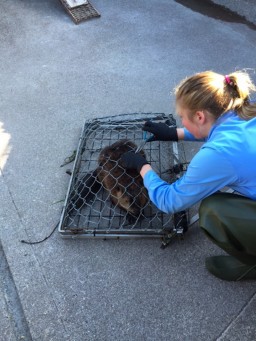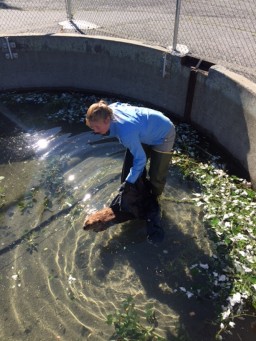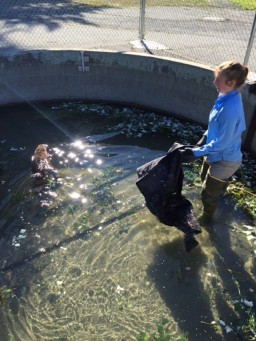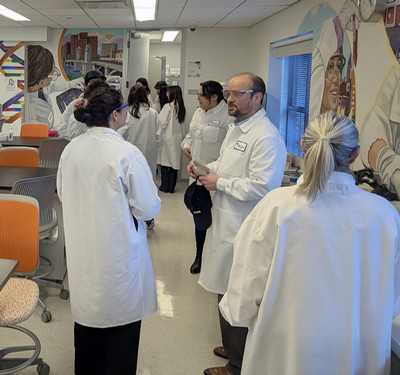Summer Jobs: Two Students Study, Protect Beavers and Whales
By Rebecca Goldfine
In about a week, Dana Bloch ’17 will depart for Rarotonga, the largest of the Cook Islands, to work for a whale research and conservation organization based there.
Satya Kent ’19 has already begun working for a program that is relocating beavers to high ground in order to conserve water for valley regions beset with drought.
Both Bloch and Kent received funded-internship grants from Bowdoin’s Career Planning office this summer. These donor-funded grants provide students with enough to live on so they can pursue unpaid internships and projects around the world.
A summer of whale research
For much of the past year, Bloch has been preparing for her summer in the Cook Islands by assisting the director of the Center for Cetacean Research and Conservation, Nan Hauser. Hauser lives half the year in Brunswick, Maine, and the other half in the South Pacific archipelago nation of the Cook Islands. Hauser founded the Cetacean center on Rarotonga 25 years ago because it gives her easy access to the mating and birthing grounds of migratory humpback whales.
Once Bloch joins Hauser on Rarotonga, she will head out on regular boat expeditions to gather data primarily on humpback whales, we well as on other whales and dolphins. In recent years, Hauser’s research has looked at how whales affect the ocean’s carbon cycle and how they are being affected by climate change. She also studies the impacts of noise pollution on whales, whale acoustics and songs, genetics, surface and underwater behavior, navigation, and migration.
Besides conducting research, Hauser’s organization focuses on education and conservation. Her team tags whales so satellite trackers can help fishing boats and ocean liners avoid them. Hauser also played a major role in the creation of a whale sanctuary in the Cook Islands, and her whale education center in Rarotonga attracts local people, students, and tourists.
Since she was a young girl, Bloch said she has loved and been fascinated by the ocean, an interest that has only grown the more she has studied it in classes at Bowdoin. “The ocean is so beautiful, but it’s also important,” Bloch said. “I want to help people realize that we need to protect it not just for its beauty but for its significance, including oxygen production and carbon sequestration.”
A summer working with beavers



Rising sophomore Satya Kent received a Strong/Gault Social Advancement grant to work for the Methow Salmon Recovery Foundation, which is working to restore habitat for fish and wildlife in eastern Washington state. One of its projects is to establish new beaver colonies at high elevations to help alleviate drought conditions in the Methow River watershed, an area of about 2,000 square miles that drains the North Cascade mountains.
Beaver wetlands can be helpful to the surrounding area because they filter sediments and pollutants from streams, and spread rivers across floodplains, allowing water to percolate into aquifers. Beaver-made wetlands also provide rearing grounds for young fish, limit flooding, and keep small creeks flowing year-round.
About a decade ago, the Methow-based foundation established a hotline that local people use to report “nuisance beavers” that are tampering with farms or fruit orchards. Biologists then trap the animals and bring them back to a man-made beaver pond. They wait until the beaver bonds with another captured beaver (typically a male and female will bond, but sometimes two males pair up) before relocating the two beavers to a new site in the mountains.
Kent says the biologists select sites that offer a good supply of beaver-friendly food (aspen, alder or dogwood trees) as well as a relatively low gradient stream. “Then we come back and monitor the site to see if they’re there and inhabiting it,” she continued. “Sometimes they stick and sometimes they don’t.” This summer, Kent is looking into why beavers might abandon some sites to provide better data to the biologists who scout and choose them.
If they do stick with their new home, the beavers build dams, transforming the stream ecology and creating reservoirs of water. These reservoirs can help prolong the release of water to the valley below throughout the dry season.
Since 2008 (the first year of the project), 328 beavers have been relocated, according to Kent. The organization estimates that for every acre of beaver-pond surface water created, a million gallons of water are stored above ground, while an additional 13 million gallons are stored below ground. Kent says she’s been amazed to learn what beavers can accomplish. “They can transform a tiny trickle of a stream into a whole wetland,” she said.
Kent grew up in the small town of Okanogan, one valley over from the Methow. After graduating from high school, she volunteered with the Methow Beaver Project last summer. This summer, she’s even more immersed in every stage of the project, from responding to the hotline and trapping the beavers, to relocating them to their new homes and monitoring the new sites. She said she hopes the experience will give her a better sense of whether she wants to pursue a career as a field biologist.



